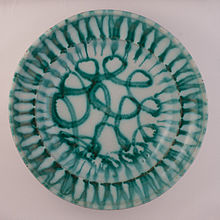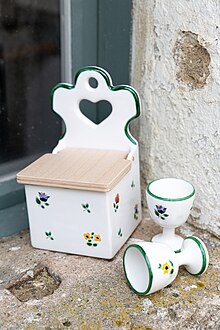Gmundner ceramics
Gmundner Keramik is an Austrian ceramic brand from the Gmundner Keramik Manufaktur from Gmunden in the Salzkammergut .
Even today, all work steps, from the preparation of the raw material to the painting of the individual pieces, are 100% carried out in Austria. According to an old tradition, painting is done by hand and using a special technique. A world of experience at the production site in Gmunden lets you take a look behind the scenes of production. There is one brand store each in Vienna, Salzburg and Hallstatt.
Factory tour
If you want to take a look behind the scenes of the manufacturing site in Gmunden, you can do so, for example, during a factory tour, which is offered all year round in all weathers and is also child-friendly. In addition to a short film, some particularly valuable exhibits, a tactile and a photo station, guests are offered detailed insights into the creation of the Gmundner ceramics unique pieces and the painting workshops. You can also try your hand at being a ceramic painter at a painting workshop in the atelier café on site and paint your own unique Gmundner ceramic with original tools and expert advice. In addition, the location offers two sales shops in which the entire range of first and second choice is immediately available to take away. In the summer months, the in-house coffee shop is also open to visitors and offers self-righteous cakes & coffee in style on Gmundner ceramics.
History of Gmundner Keramik
The history of Gmunden ceramics goes back far into the past, as archaeological finds in the town of Gmunden at the northern end of the Traunsee prove. Gmundner ceramics was mentioned in a document as early as 1492 . In the decades and centuries that followed, the company focused on figural art until, when it was taken over by Johannes von Hohenberg in 1968, the main focus was placed on the production of high-quality tableware, for which Gmundner Keramik is world-famous today.
Development in the 20th century to the Gmundner Keramik brand
In 1843, Franz Schleiß acquired the Hafnerhaus am Graben, which had existed since around 1500, and his son Leopold Schleiß founded the Gmundner pottery factory in 1903 on the current site of Gmundner Keramik Manufaktur GmbH . In 1909 the artistic workshop of Franz and Emilie Schleiß was established. Artists such as Peche, Jungnickel, Anton Klieber and Willi Sitte turned Gmunden into an artist colony in the summer months between 1913 and 1923. Franz von Zülow and Paul Hartmann taught in the ceramic training workshop founded in 1917 . Michael Powolny , Herta Bucher and Matthäus Fellinger worked closely with the Schleiß family. The German-American designer Tommi Parzinger , who came from Munich, also worked for the Schleiß family's workshops in the 1920s.
The company was converted into a stock corporation in 1923 , whereby Franz Schleiss lost the majority of the capital. The war years did not leave the company without a trace. Karl Födinger was forced to take involuntary work interruptions several times.
The company Gmundner Keramik , which had specialized in the manufacture of ceramic objects by hand, received its official approval with the trade license issued on September 15, 1931. After repeated changes in ownership, Johannes Hohenberg (a son of Maximilian Hohenberg ) acquired the company in 1968 . While figural art had mainly been devoted to this point in time, the production of tableware began to be increased. The green flamed was a great success and the Gmundner Keramik became a household name throughout the country.
Owner, business data
In 1973 a new workshop was built so that large delivery orders could now be carried out. In 1975 the company received the state award and has been allowed to use the federal coat of arms in business transactions ever since .
In 1976 the company employed over 20 people. In autumn 1997, the Salzburg entrepreneur Johannes Moy de Sons (owner of Schloss Anif ), who previously held only 26 percent, took over 79 percent of the company's shares from the Hohenberg family, who were friends. The Moy'sche private foundation held another eleven percent. The remaining percent belonged to Wolfgang Stier, the director of Moy's estate administration. From 1997 Moy led the company until he handed over the reins to his son Max Moy in 2011. He ran the manufacture until August 2018. On August 1, 2018, it was announced that Moy had sold the company to Markus Friesacher's MF Group . The Friesacher Group has been running the business ever since.
The company says it is the only one in Austria to train apprentices to become ceramic painters. As of August 2018, the Gmundner Keramik Manufaktur employs 130 people, 40 of whom are painters, making it the largest ceramic manufacturer in Central Europe. The production capacity is around 5000 pieces per day.
Products and sales
A major modernization of the company was the adjustment of the quality to today's standards. Gmundner ceramics are dishwasher and microwave safe.
Traditional and new designs
The traditional designs Scattered Flowers and Flamed Green still make up a major share of sales. In 2003 the new Traunsee decor (flamed dark blue-green) was presented. In January 2005 the artistic series Gmundner Selektion came on the market. Two new designs were created for the 2014 Christmas edition, the pink deer and Toni - the skier . In 2016, the Pur Geflammt design brought a reinterpretation of the classic Flamed to the market. The Herzerl Rosa design was developed for the 2017 Christmas edition . Since May 2019, the range has also included the designs flamed white with haptic flaming and the heart gray design .
Current designs:
- Flamed: green, yellow, blue, gray, red, white, colored flamed, Traunsee and Landlust
- Pure flamed: green, yellow, blue, gray, red
- Edge: green and gray
- Selection: apple green and ruby red
- Scattered flowers
- Deer: green, gray, ruby red, claret, pink
- hunt
- Variation: green, gray, ruby red, burgundy red, blue
- Hearts Pink & Hearts Gray
In order for the unique items to remain as a service in the long term, the manufactory offers the option of re-purchasing all design classics on a place setting (coffee cup, saucer, dessert plate, soup plate and dinner plate) for an unlimited period of time.
Distribution of Gmundner ceramics
According to its own information, Gmundner Keramik is the market leader in the home market in the area of tableware. Germany is the most important export market. Further destinations are Japan, USA, Slovenia, Italy, France, England, Switzerland. The export share is 30%.
literature
- City of Gmunden: Gmunden - 700 years of the city . Gmunden, 1978.
- Irmgard Gollner: Gmundner Ceramics - Art from clay, fire & color . Gmunden, 2003.
Web links
Individual evidence
- ↑ Ex-racing driver Friesacher buys Gmundner Keramik diepresse.com, August 1, 2018, accessed August 1, 2018
- ↑ http://ooe.orf.at/news/stories/2701685/ Gmundner Ceramics managed Wende, ORF.at March 25, 2015





